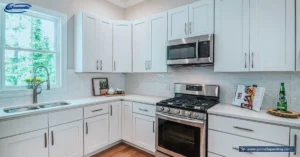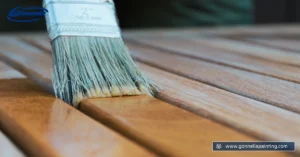Table of Contents
TogglePaint Safety During Surface Preparation
A fresh coat of paint can transform a tired house into the pride of the neighborhood, boosting curb appeal and overall value. Before you scrape, prime, or apply the finish coat, set up a tidy and hazard-free workspace. Move or cover furniture, lay down taped canvas drop cloths, and clear traffic paths so no one trips. Keep children and pets elsewhere until the job is complete.
Prep Like a Pro
Professional‑quality results start long before the brush meets the wall. Clean every surface to remove grime, grease, and dust. Sand rough spots or peeling paint. Patch holes and cracks so the surface feels smooth under your fingertips. Tape off trim, outlets, and hardware so you only paint what you intend. These steps help the coating adhere properly and create a flawless finish.
Lead Testing
Homes built before 1978 can contain lead‑based paint. Use an EPA‑approved test kit or hire a certified inspector before sanding or scraping. Lead dust is highly toxic, especially to children and pregnant women. If tests confirm lead, hire a contractor licensed for lead paint removal to contain debris, use HEPA vacuums, and dispose of waste safely.
Ventilation and Respirators
Open windows and doors, then place fans to pull fresh air through the room. Good airflow reduces exposure to fumes, even when you are using low‑VOC products. Wear appropriate respiratory protection: an N95 mask for sanding dust and a cartridge respirator when working with oil‑based paints, primers, or strong solvents. In tight or specialty paint situations, add an air filtration unit for extra protection.
Protect Electrical Outlets
Turn off power at the breaker panel if you paint near wiring. Cover outlets, switches, and ports with painter’s tape or purpose‑made outlet blockers such as Socket Blocker. These prevent drips from entering electrical components and creating safety hazards.
Paint Safety During the Painting Stage
With surfaces prepped and safety in place, you are ready to apply primer and finish coats. Keep materials organized and maintain a clear exit path at all times.
Choose the Right Paint
Water‑based paints suit most interiors because they clean up easily and emit fewer fumes. Oil‑based products offer extra durability on trim and high‑wear areas but require stronger ventilation. Read labels and pick low‑VOC or zero‑VOC formulas whenever possible.
Choose the Right Paint Finish
Match the sheen to each room for durability and appearance:
- Flat or Matte hides imperfections on ceilings and low‑traffic walls.
- Eggshell offers a soft sheen suitable for bedrooms and dining rooms.
- Satin cleans easily, making it ideal for living rooms and hallways.
- Semi‑Gloss resists moisture and stains, perfect for kitchens, baths, and trim.
- Gloss delivers a durable, shiny surface for cabinetry and accents.
Invest in Quality Supplies
High‑quality brushes, rollers, and painter’s tape save time and deliver smoother results. Choose angled, flagged‑tip brushes for clean edges and lint‑free rollers for even coverage. Premium paint provides richer color and better hiding power, so you need fewer coats and enjoy a finish that lasts.
Don’t Skip the Primer
Primer seals porous surfaces, blocks stains, and promotes adhesion. Use it when you cover dark colors, paint bare drywall, or switch between drastically different shades. One extra coat now prevents peeling and patchiness later.
Use the Same Techniques as the Pros
Paint edges and corners with a brush first, then roll larger areas. Move the roller in an overlapping “W” or “M” pattern for even distribution. Keep a wet edge to avoid lap marks, and work under natural daylight or bright work lights to spot drips before they dry.
Floor Protection
Cover flooring with canvas or heavy plastic sheeting. Tape edges to reduce trip hazards and wipe spills immediately to prevent slips.
Ladder Safety
Inspect ladders before use, place them on level ground, and maintain three points of contact while climbing. Do not overreach—climb down and reposition instead. If the project involves high peaks, steep roofs, or multi‑story work, consider hiring a professional painter.
Protect Your Hands and Eyes
Wear disposable nitrile or latex gloves when handling paint, thinners, or solvents. Put on safety goggles during sanding or spraying to shield eyes from splatter and dust.
Use Proper Lighting
Bright, even lighting reveals thin spots, drips, and missed edges. Position portable work lights if daylight is limited.
After the Completion of Your Project
Finish strong by cleaning tools, disposing of waste correctly, and storing supplies safely.
Disposal of Paint
Never pour paint or solvents down the drain. Dry leftover latex paint in the can or mix it with kitty litter until solid, then dispose of it with household trash where permitted. Take oil-based paints, thinners, and solvent waste to a hazardous-waste facility or a retail take-back program, such as those offered by some major paint stores.
Handling Rags Contaminated with Oil Paint or Paint Thinner
Spread rags to dry in a well‑ventilated area away from heat, or store them in a metal can submerged in water with a tight lid before transporting them to hazardous‑waste collection. This prevents spontaneous combustion.
Paint and Paint Thinner Storage
Seal lids tightly and store containers on shelves in a cool, shaded space away from gas appliances. Properly stored latex paint lasts two to five years, while oil‑based products often last longer. Discard paint that smells sour or shows heavy separation.
Bonus Tip: Know When to Call Professional Painters
Tall ceilings, intricate trim, strict deadlines, and exterior jobs often demand professional skill, specialized equipment, and extra manpower. Experienced painters complete projects faster, deliver uniform results, and back their work with warranties, saving you stress and ensuring lasting quality.
Call Gonnella Painting & Restoration if you need residential painting services.
Conclusion
A well‑planned painting project enhances beauty, protects surfaces, and adds real value to your home. Test for lead, ventilate thoroughly, wear proper protection, and use quality supplies to achieve professional‑level results. Handle waste responsibly and store paint correctly so your work remains safe and durable. When challenges exceed your comfort level, bring in a trusted painting contractor to finish the job with confidence. Enjoy your fresh, vibrant space knowing you followed best practices from start to finish.






